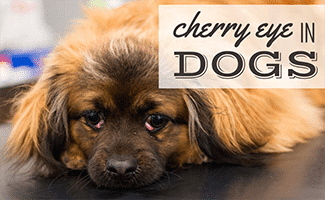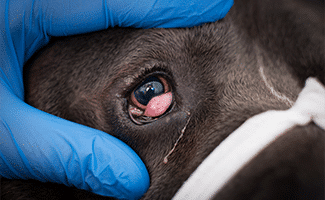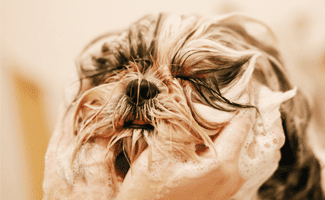
To keep the lights on, we receive affiliate commissions via some of our links. Our review process.

It may come as a surprise to us humans, but dogs have three eyelids. This third eyelid is called the nictitating membrane, or nictitans. It emerges from the inside corner of the lower eyelid to cover the eye diagonally, serving as an additional lubricating barrier to protect the fragile surface of the eye (cornea). Let’s learn more about cherry eye, possible treatment options, and what causes the condition to begin with.
What Is Cherry Eye?
Contents
This third eyelid is made of muscle fibers, soft pink tissue (conjunctiva), and cartilage. It also contains a small gland the size of a cherry pit, called the nictitans gland, or the “lacrimal gland of the third eyelid.” This small gland produces about one-third of a dog’s tears. Under normal circumstances, the gland and the third eyelid are both hidden away, and all you can see is a small pink triangle in the inside corner of the eye.
But sometimes, the gland can suddenly pop out in one eye and occasionally in both eyes simultaneously. This is called a prolapse of the nictitans gland — more commonly known as cherry eye.
What Causes Cherry Eye In Dogs?

The nictitans gland is normally held in place under the lower eyelid by connective tissue fibers. However, these fibers can become weak in some individuals, allowing the gland to pop out.
Young dogs under the age of two are most prone, as the issue is thought to be genetic and hereditary. Predisposed breeds include dogs with a short snout (brachycephalic dogs), such as English and French Bulldogs, Boston Terriers, Pugs, and Lhasa Apsos. Other predisposed breeds include Cocker Spaniels, Beagles, Shar-Pei dogs, and giant breeds such as Newfoundlands, Great Danes, Cane Corsos, and Mastiffs.
More often than not, a specific reason for the gland to suddenly pop out isn’t found, other than the dog having a genetic predisposition. However, the gland can sometimes pop out more readily if it’s become swollen or inflamed. Seasonal allergies can cause such swelling and inflammation, and several pet parents have reported the sudden appearance of a cherry eye after an intense session of wrestling or play.
How To Treat Cherry Eye In Dogs
Because this condition is usually caused by a weakening of the connective fibers in the third eyelid, it’s imperative to understand that cherry eye often becomes a chronic and recurring problem in dogs. Though it’s not always the case, many dogs will need surgery to tack in the cartilage and help the eyelid “hold” in the gland where it belongs.
Though a cherry eye isn’t a severe issue at first, the longer the gland is left out of its protective pouch, the harder it becomes to correct the problem. Over time, this will often lead to serious complications such as KCS (Keratoconjunctivitis Sicca, which means dry eye). KCS is uncomfortable and can require lifelong treatment of the affected eye and regular veterinary checks. Early intervention is essential if your dog has a cherry eye.
How To Manage A Cherry Eye

If you have just noticed a cherry eye on your dog for the first time, it’s best to see your veterinarian as soon as possible. They will usually try to gently pop the gland back in, check for any underlying issues or damage to the eye, and talk you through the next steps. Depending on the situation, this might involve a “wait and see” period where it may be possible to tackle any underlying cause such as seasonal allergies while keeping the eye lubricated.
However, in many cases, your veterinarian will talk to you about getting mentally prepared for surgery, as cherry eye often becomes a recurring problem. Thankfully, this surgery is usually simple and not very invasive.
Home Remedies For Cherry Eye In Dogs?
The longer the gland stays exposed, the harder it can be to pop it back in, and the more issues can follow, such as the eye’s surface becoming too dry, trauma to the cornea from repeated rubbing, and damage to the gland itself. Therefore, it’s ill-advised to try and treat a cherry eye at home without seeing your vet first. This being said, there are some things a pet parent can do at home that might help.
Artificial Tears
Cherry eye is usually not painful when it has just happened, and many dogs will tolerate their pet parents gently applying plain artificial tears to the affected eye while they wait to be seen by their veterinarian. Don’t attempt this if your dog is fighting you or you’re unsure you have the correct product. Most of all, don’t use anything other than plain artificial tears without speaking to your veterinarian first. Eyes are incredibly sensitive, and the wrong substance, even one deemed “natural,” can be very irritating and cause further issues.
Cool Tea Bag Compress
Some dog parents report having some success with managing a sudden cherry eye at home by applying a cool teabag to the eye for a few minutes while keeping the dog calm and relaxed. The teabag shouldn’t be dripping: we’re not trying to get tea into the dog’s eye. The goal is to apply something damp, soothing, and cool before attempting to massage the gland back into place.
Massage

With the dog relaxed or even sleepy, some pet parents have had success with gently massaging the lower eyelid to coax the gland back into place.
Please understand that these suggestions are not a substitute for seeing your veterinarian immediately and should only be attempted in the interim if you cannot be seen rapidly.
Early-Stage Cherry Eye In Dogs
A separate condition called “scrolled (or everted) cartilage of the third eyelid” can look like a cherry eye in some dogs. When people first see it, they sometimes wonder if it might be an early-stage cherry eye, but the conditions are different.
Everted third eyelids tend to happen in giant breeds due to the T-shaped cartilage inside the eyelid growing too quickly in young dogs. Instead of sitting snugly on the eye’s surface and evenly distributing the tears, the rapid growth causes the eyelid to ripple and pucker out a bit, like a scroll of paper. This isn’t the early stage of a cherry eye, but both conditions can happen simultaneously (giant breeds are prone to both) and can cause similar issues, like the dreaded dry eye.
Severe Cherry Eye In Dogs

Though most cases of cherry eye are straightforward, there can occasionally be complicating factors that make them trickier to manage. As described above, there might be a scrolled third eyelid, or the eye might already be suffering from KCS (dry eye) and be very sore, red, and inflamed.
There might be scarring and discoloration of the cornea, or the gland may be thickened, swollen, and red. In these cases, the normal “tucking” surgery may be unsuccessful, and a referral to a veterinary ophthalmology specialist might be suggested to maximize the chances of success.
It was fairly routine to remove the gland in the past, as its importance was not fully understood. This approach has widely fallen out of favor because it will often cause severe KCS, and it’s generally the consensus now that the third eyelid gland shouldn’t be removed unless there’s a very good reason to do so.
Frequently Asked Questions
Here are some common questions from dog owners who have dogs that experience cherry eyes.
Can I Use Eye Drops For Cherry Eye In Dogs?
The short answer is no — cherry eye means the third eyelid gland is mechanically prolapsed out of its little pocket and must be manually replaced. In some cases, this can be achieved through lubrication and massage, and your veterinarian might prescribe drops in the short term to help keep the inflammation in check. But in most instances, eye drops alone aren’t adequate to fix the problem.
What Else Can Cause Third Eyelid Elevation In Dogs?
The third eyelid can sometimes come up and be more visible inside a dog’s eye without an actual cherry eye. Scrolled eyelids are one of the reasons we mentioned above, but there are other reasons why this might happen, usually because of eye soreness and occasionally for other reasons such as Horner’s Syndrome. If you notice your dog’s third eyelid elevated, it’s best to see the veterinarian right away as eye problems can be very sore and often require rapid intervention.
Other Possible Eye Conditions
Cherry eye is a fairly common condition in dogs, especially in certain breeds. It’s important to see the veterinarian as soon as the cherry eye is noticed to avoid any complications. Though pet parents can learn how to manage the occasional episode at home, most of these dogs end up needing surgery to prevent further episodes. If your dog’s eyes are red, don’t completely rule out other possible issues, including glaucoma, conjunctivitis, or uveitis.
Tagged With: Eyes